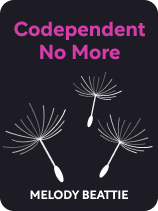

This article is an excerpt from the Shortform book guide to "Codependent No More" by Melody Beattie. Shortform has the world's best summaries and analyses of books you should be reading.
Like this article? Sign up for a free trial here .
Are you plagued by stress and guilt? Do you forget to take care of yourself because you’re busy managing other people’s lives?
Codependent No More is a guide to reclaiming your life from codependency. Melody Beattie encourages readers to overcome codependency with powerful messages about finding yourself, recovering self-esteem, and living a life that’s free and full of joy.
Continue reading for nine Codependent No More exercises that will help you break free from codependency.
9 Codependent No More Exercises
Codependency is a reaction to stress in which a person becomes obsessed with another and loses sight of themself. Known as the “queen of codependency,” Melodie Beattie introduced codependency to the wider world. She draws on her own experience as a codependent, addict, and counselor to present a realistic yet compassionate image of codependents and their struggles.
The following Codependent No More exercises will help you apply the book’s principles.
Exercise #1: Identify Your Family’s Rules of Engagement
According to Beattie, the unspoken rules that govern family interaction can either promote or stifle open communication. Families that discourage communication have a high risk of codependency. Understanding these rules of engagement can help you communicate better and foster better relationships.
- Identify some of the unspoken family rules that determine how you interact with others. For instance, are there any emotions you feel unable to express or any topics that are taboo due to your family’s expectations? Were you taught you have to act or look a certain way? Write down all the examples you can think of.
- Now, describe a recent interaction with someone where these rules affected how you behaved. Did you avoid talking about something? Did you hide your feelings? Try to connect your behavior to the family rules you listed above.
- Finally, describe how that interaction might have changed if your family rules were different. What might you have said or done differently? Try to find a different, positive action for each family rule that affected the original interaction.
Exercise #2: Practice Detachment
According to Beattie, detaching means focusing your energy on your own needs and wants and allowing other people to fulfill their own responsibilities. Learning to recognize situations where you’re attached to someone can help you prioritize self-care.
- Think back to a situation where you prioritized someone else’s responsibilities over your own wants and needs. (Maybe you did your teenage son’s laundry, rather than reading the book you’ve been looking forward to.) What happened? What did you need or want, and what did you do instead?
- Next, describe what would have happened if you had prioritized your wants and needs instead. (Be realistic: Your son might be upset, but it wouldn’t be a disaster if he had to do his own laundry or wear dirty clothes to school.)
- Finally, write out a plan for the next time you encounter this situation. (You might send your son a text reminding him to do his laundry, put your phone away, and then go enjoy your book.) Be specific with actionable steps.
Exercise #3: Stop Caretaking and Start Empowering
Beattie’s caretaking cycle is based on the Karpman Drama Triangle and its roles of rescuer, persecutor, and victim. You can escape the Drama Triangle by shifting your mindset to the Empowerment Dynamic and its roles of coach, challenger, and creator.
- Describe a time you started the caretaking cycle by “saving” someone from their responsibilities and what happened when you “saved” them.
- What could you have done differently to be a coach rather than a rescuer in this situation?
- Now, describe what happened when you shifted to the anger stage. What could you have done differently to be a challenger rather than a persecutor?
- Finally, describe what happened when you moved to the victimization stage. What could you have done differently to be a creator rather than a victim?
Exercise #4: Trust Your Mind
Many codependents struggle to trust their own judgment. You are more capable than you think, and reminding yourself of times you’ve succeeded in the past can build your confidence and help you make decisions in the present.
- Describe a decision you’re worried about making and why you’re worried about it. What do you think will happen if you make the wrong decision?
- Now, think about three good decisions you have made in the past. Describe those situations and how you felt before making the decision. Were you worried or confident?
- Describe why those situations turned out well and what made the decision the right one.
- How can you take those good experiences and apply them to your current situation?
Exercise #5: Release Unhealthy Guilt
Many codependents struggle with unhealthy guilt. Unhealthy guilt is based on thoughts and feelings rather than actions, and it makes you anxious instead of motivating growth. Releasing unhealthy guilt will let you grow as a person and live a happier, more authentic life.
- Make a list with two headings: Healthy Guilt and Unhealthy Guilt. Think about times you felt guilty, or things you feel guilty for right now. Ask yourself, “Is this guilt based on an action (healthy) or a feeling (unhealthy)? Does it motivate (healthy) or paralyze (unhealthy) me?” and divide the situations under the headings accordingly.
- Look at the situations under the Unhealthy Guilt heading. Describe why each situation is unhealthy. (For example, you might say, “I feel guilty for being angry at my wife and feel anxious and paralyzed because of it. This is unhealthy guilt because I reacted appropriately to my anger. I stayed calm and discussed the issue instead of lashing out, so I have nothing to be worried or guilty about.”)
- Look at the situations under the Unhealthy Guilt heading and write out a plan for letting go of the unhealthy guilt. (For example, you might write down the reasons for your unhealthy guilt on a piece of paper and tear it up to find closure, or you might repeat a mantra to release guilt every day.) Be specific and schedule times to put your plans into action.
- Look at the situations under the Healthy Guilt heading and write out a plan for dealing with each one. (For example, maybe you need to make amends, apologize, or plan how to do better in the future.) Be specific and schedule times to put your plans into action.
Exercise #6: Figure Out Your Real Responsibilities
Codependents are bad at taking responsibility. They try to control things that aren’t their responsibility while ignoring their real duties. Determining your real responsibilities will let you focus your energy where it needs to be.
- Write out the things you feel responsible for. To aid with this, look at your past actions and see what they can tell you about the things you feel responsible for. (For example, you might not consciously think you’re responsible for your sister’s mood, but if you’re always avoiding conversations that might upset her and ignoring your own needs to keep her happy, you probably feel that way subconsciously.)
- Next, divide these responsibilities into two categories: Mine and Not Mine. Under each responsibility, write in detail about why it’s yours or not yours. Think about the following questions to help you decide which category to put each responsibility under: Can you really control each responsibility? If so, are you taking away someone’s right to choose? (For example, if you try to control your sister’s mood, you’re taking away her right to choose how she reacts to difficult conversations.)
- Look at the responsibilities under the Not Mine category. Make a plan for how you’re going to release each of them. Be specific, with actionable steps. (For example, if you always rearrange your schedule when your boyfriend wants to spend time with you, you can write out what you’ll say to turn him down the next time. You could also organize your calendar according to how important the activity is; then you’ll have a clear idea of what activities you can rearrange and which ones take priority.)
Exercise #7: Process Your Emotions
Processing your emotions is a vital skill. When you process your emotions, you are in control of your actions and can make good decisions. By walking through the healthy and unhealthy ways to react to your emotions, you can get some distance from the situation and decide how to react with a clear head.
- Think about a difficult emotion you’re feeling now or felt recently. Describe why you’re feeling that emotion, what you think about it, and what you’ve done to process it. (Have you taken responsibility for the emotion? Have you remembered that it doesn’t define you?)
- Now, write about your unhealthy reactions to that emotion. (Are you lashing out? Are you blaming other people?) If you have trouble picturing yourself reacting unhealthily, imagine someone else doing so.
- Finally, write about your healthy reactions to that emotion. (Are you using “I” statements? What can you learn from this emotion?) Describe how you might use these healthy reactions more often. Again, if you have trouble picturing yourself reacting healthily, imagine someone else doing so.
Exercise #8: Set Goals
Goals let you look forward to the future: They are a healthy method of acknowledging your desires. By examining your goals and planning how to complete them, you can improve your self-esteem and find the motivation to live for yourself.
- Write down a list of your goals. Be creative and don’t limit yourself. You can put down wants, needs, pipe dreams, or anything you’d like! (If you’re not sure about your goals, pick some of the examples discussed in the book.)
- Pick one of your more immediate goals. (“Have fun” is a more immediate goal than “Enjoy peace,” for example.) Write about what this goal looks like for you and why you want to achieve it.
- Have you done any work to reach this goal already? If so, describe the work you’ve done and how effective it’s been. If not, describe why not.
- Now, make a plan for reaching this goal. (If you choose the “Have fun” goal, for example, you could write about the different clubs and activities you’re going to try. If you choose the “Take care of your body” goal, you could talk about donating clothes you don’t like, buying some new clothes, or trying out a new hygiene routine.) Be specific, and include small, actionable steps that you can realistically take.
Exercise #9: Process the Past
Processing the past is a necessary part of healing. Giving yourself permission to feel bottled-up emotions from your childhood lets you complete the grieving process and find acceptance. Writing about your feelings gives you the distance to understand and learn from them.
Note: Processing past traumas can bring up a lot of negative and powerful emotions. Though you need to experience these emotions to heal, make sure you are in a safe place both physically and mentally first.
- Think back to a painful or significant moment in your life, perhaps from your childhood. Describe what happened. What did you feel at the time? How did you handle it?
- Now, describe how you feel about the event in the present. (Are you still holding onto any of your past emotions? If so, why do you think that is? Have the emotions changed at all?)
- Describe how completing this exercise has made you feel. (Are you more at peace or more upset?) Why do you think you feel this way?
- Finally, make a plan for processing your emotions going forward. (For example, you could journal about your feelings every night to process them instead of repressing them.) Be specific, and include actionable steps.

———End of Preview———
Like what you just read? Read the rest of the world's best book summary and analysis of Melody Beattie's "Codependent No More" at Shortform .
Here's what you'll find in our full Codependent No More summary :
- What inspired codependency 12 Step Programs around the country
- Explanations, advice, and compassion for people struggling with codependency
- How to practice detachment, self-care, and personal responsibility






